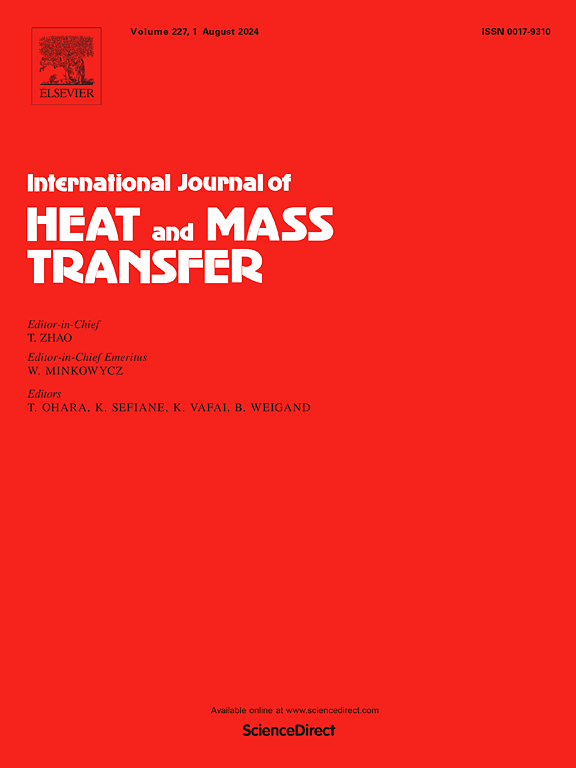An accurate Ghost Cell Immersed Boundary Method for compressible flows with heat transfer
IF 5
2区 工程技术
Q1 ENGINEERING, MECHANICAL
International Journal of Heat and Mass Transfer
Pub Date : 2025-06-26
DOI:10.1016/j.ijheatmasstransfer.2025.127314
引用次数: 0
Abstract
In the present study, we analyze and develop Ghost Cell Immersed Boundary Method (GCIBM) formulations for heat transfer between compressible flows and isothermal surfaces. In particular, we focus on the accuracy of the temperature gradient (or Nusselt number) at the immersed boundary under Dirichlet boundary conditions. We first examine the influence of the chosen interpolation scheme for image point reconstruction on the solution accuracy. We demonstrate that the Triangular Shaped Cloud (TSC) interpolation can significantly reduce numerical fluctuations induced by spatial localization errors in comparison with the commonly used bi-linear interpolation. Then, we show that for both interpolation schemes, the standard ghost cell extrapolation treatment for Dirichlet boundary conditions achieves a -order solution for the flow variables, but only a -order solution for the Nusselt number. To remedy this issue, we suggest a high-order ghost cell extrapolation treatment that involves two image points. We extensively verify our new high-order extrapolation ghost cell treatment against existing benchmarks from the literature, and compare its performance against the standard ghost cell extrapolation approach. We show that our new high-order ghost cell extrapolation treatment combined with the TSC interpolation scheme achieves a -order accurate solution devoid of numerical fluctuations for the Nusselt number, whereas the standard image point extrapolation procedure leads to a -order accurate solution for the Nusselt number. Extensive tests demonstrate these properties for multi-dimensional heat conduction problems and subsonic solutions of the compressible Navier–Stokes equations with heat transfer. Furthermore, for supersonic flows that involve shock waves, we show that a higher than -order accurate solution for the Nusselt number can be obtained using the high-order image extrapolation procedure. On the contrary, the standard image point extrapolation procedure leads to an order of accuracy lower than unity for the Nusselt number. Finally, we verify our new method against results from the literature for 3-D solutions of the compressible Navier–Stokes equations with the inclusion of heat transfer.
可压缩传热流动的精确鬼胞浸入边界法
在本研究中,我们分析和发展了鬼胞浸入边界法(GCIBM)的可压缩流和等温表面之间的传热公式。特别地,我们关注在Dirichlet边界条件下浸入边界处温度梯度(或Nusselt数)的准确性。我们首先考察了图像点重建所选择的插值方案对求解精度的影响。研究表明,与常用的双线性插值相比,三角形云(TSC)插值可以显著降低空间定位误差引起的数值波动。然后,我们证明了对于这两种插值方案,Dirichlet边界条件的标准鬼胞外推处理获得了流变量的二阶解,但只有努塞尔数的一阶解。为了解决这个问题,我们建议采用高阶鬼细胞外推处理,包括两个图像点。我们根据文献中的现有基准广泛验证了我们新的高阶外推鬼细胞处理,并将其性能与标准鬼细胞外推方法进行了比较。我们表明,我们的新高阶鬼细胞外推处理与TSC插值方案相结合,可以获得Nusselt数的二阶精确解,而标准图像点外推程序可以获得Nusselt数的一阶精确解。大量的测试证明了这些特性的多维热传导问题和亚声速解的可压缩的Navier-Stokes方程与传热。此外,对于涉及激波的超音速流动,我们证明了使用高阶图像外推程序可以获得高于一阶的努塞尔数精确解。相反,标准的图像点外推程序导致努塞尔数的精度低于1个数量级。最后,我们用文献的结果验证了我们的新方法,得到了包含传热的可压缩Navier-Stokes方程的三维解。
本文章由计算机程序翻译,如有差异,请以英文原文为准。
求助全文
约1分钟内获得全文
求助全文
来源期刊
CiteScore
10.30
自引率
13.50%
发文量
1319
审稿时长
41 days
期刊介绍:
International Journal of Heat and Mass Transfer is the vehicle for the exchange of basic ideas in heat and mass transfer between research workers and engineers throughout the world. It focuses on both analytical and experimental research, with an emphasis on contributions which increase the basic understanding of transfer processes and their application to engineering problems.
Topics include:
-New methods of measuring and/or correlating transport-property data
-Energy engineering
-Environmental applications of heat and/or mass transfer

 求助内容:
求助内容: 应助结果提醒方式:
应助结果提醒方式:


